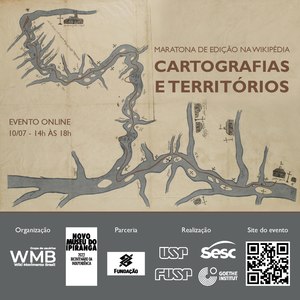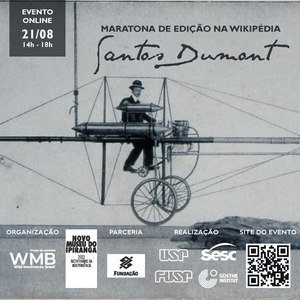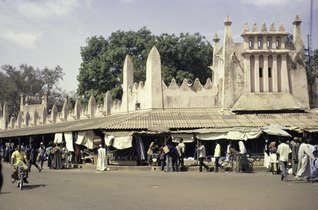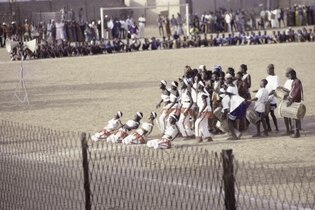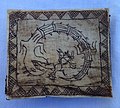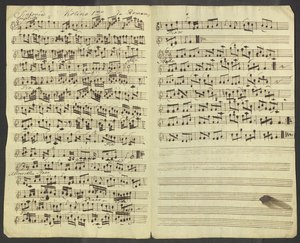GLAM/Newsletter/July 2020/Single
|
Wikimedia CEE Spring 2020 in Albania and Kosova
Wikimedia CEE Spring 2020 - 2 day edit-a-thon
On May 9-10, 2020, Wikimedias of Albanian Language UG, held online - Cee Spring 2020 - edit-a-thon, where Albania and Kosovo participated in the competition organized by the Wikimedians of Central and Eastern Europe. During the two days, the focus was on writing new articles about the culture and history of Central and Southern European countries on Albanian Wikipedia. We had the participation of 11 people from Albania and Kosovo who worked individually online from home for the event. All In two days, a total of 113 new articles were written and a total of 123 articles were improved for the culture of Central and Southern European countries.
Results
In Wikipedia Albania during 2 months we had a total of 265 articles. To thank the contributor we bought gift card, so they could buy books they liked. We bought the card and left them to the shop, to make sure everyone would be safe of COVID-19. Also, we asked them to write to us the most interesting things they learned during the competition, and we shared the "facts" on our social media.
New WikiClub and Australian GLAM Research
New National Gallery of Australia WikiClub
Further to our story last month about online training for new editors at the National Gallery of Australia, Wikimedia Australia is excited to welcome our newest WikiClub, NGA WikiClub. This ongoing group of new editors are meeting weekly (currently online) as an opportunity for Gallery volunteers to continue creating and improving articles and to share their experiences and achievements. Welcome to NGA WikiClub facilitators Simon and Linda, who are being well-supported by Australian Wikimedians. NGA WikiClub will build a sense of community for those involved in an exciting project to support the Gallery's Know My Name exhibition.
Research: Wikidata Engagement with Australian GLAMs
Recognising a lack of awareness of Wikidata in the Australian GLAM sector, Wikimedia Australia designed a project that could be undertaken during the period when face to face activities were not possible. We were pleased to engage Rebecca Hawcroft, a consultant with expertise in content development and the GLAM sector, to undertake this work for us. The first stage involved interviewing Australian and New Zealand Wikimedians who have been successful in engaging with the GLAM sector. Key messages from these interviews are guiding the development and trialling of materials with several GLAM institutions.
What we've learned so far
- All GLAMs are different
- Tailor content for each GLAM
- Provide examples of relevant, successful collaborations
- Provide clear channels of support and liaison between the GLAM and the movement
Important records of Brazilian history: images, metadata and edit-a-thons
The Wiki Movimento Brasil UG organized a series of events, established new partnerships and uploaded special images on ongoing GLAMs initiatives in July, with more to come in August. In this edition of the newsletter, you find the main activities developed in Brazil in the period and can easily access the links regarding them. Enjoy!
Image and metadata uploads
In July 2020, Wiki Movimento Brasil uploaded several batches of content through GLAM-Wiki partnerships with Brazilian institutions. In total, more than 680 metadata were shared on Wikidata and 220 images on Wikimedia Commons.

At first, we made the notebook of Aimé-Adrien Taunay available, in the context of the Museu Paulista GLAM. This document is considered one of the rarest items in the institution's collection and is very relevant to the history of Brazil, as it is a travel report produced during the period of exploration of the territory that is currently the southeast of the country, close to Rio de Janeiro. The notebook has illustrations and notes from 1828, with descriptions of animals, plants, people and places, which are still useful for research and teaching in different areas of knowledge.
Sharing this notebook was also useful for us to carry out our seventh edit-a-thon with this institution, the Ilustração científica: Taunay e Florence, in addition to illustrating the page about the work, Caderno de notas de Aimé-Adrien Taunay, on Wikipedia in Portuguese. It is also very important to mention the Instituto Hercule Florence, a new GLAM-Wiki partnership of the WMB and the institution that helped to digitize this item.

Next, WMB also made 470 metadata available in the GLAM of the Instituto Moreira Salles (IMS). The items are from works by renowned photographers, such as Marc Ferrez, Georges Leuzinger and Augusto Malta, who photographed between the end of the 19th century and the beginning of the 20th, recording rare and historic scenes, mainly from the city of Rio de Janeiro. In a few days, we will make the images of this upload available on Wikimedia Commons as well.
Finally, at the end of July, we also worked on making available another lot from the Museu Paulista GLAM, in the Santos Dumont Collection. There were 210 new items on Wikidata and 223 images on Wikimedia Commons, in this category. Among them are photos of the plane 14-bis and its flight at Campo de Bagatelle. In this same batch, there are records of the episode in which Dumont goes around the Eiffel Tower with his airship, in 1901, in addition to several images of the personal life of the aeronaut and several of his aeronautical inventions.
Santos Dumont is an important Brazilian historical figure, because he was one of the most famous people of the beginning of the 20th century, due to his air navigation inventions, for being the first person to take off a plane powered by a gasoline engine and is, also, considered by many to be the true inventor of the plane.
Edit-a-thons and Workshops

WMB ran in July three edit-a-thons on GLAM related topics and will be organizing one more in August. The user group also had one technical training on Wikidata, realized under the Museu Paulista partnership. All the events are happening on the online format due the pandemic in Brazil.
- Art+Feminisms: Art & Archive: This was the third event in partnership with Art+Feminism, NaPupila collective and Instituto Moreira Salles. The partnership involves a curatorial work to identify reliable sources for improving Wikipedia’s content on women of the arts. Inspired by the International Afro-Latin American, Afro-Caribbean and Diaspora Women’s Day, we gathered on a Saturday more than 50 people on Zoom for a seminar on the decolonial practice and on the archives at the Instituto Moreira Salles. Then, on Sunday, we gathered more than 20 people to edit entries on Wikipedia on black women and to honor the work of the artist Silvana Mendes. More events like this to come!
- Cartographies and territories: The Museu Paulista events are composed by a webinar followed by a practical activity online. All the videos from this activity are available on our YouTube channel. We explored on this webinar the collaborative mapping process based on OpenStreetMap developed for the museum. The editing part of the event was focused on the museum’s map collections.
- Scientific illustration: Taunay e Florence: The main theme of this event was the scientific expeditions in Brazil during the early 19th century. The beautiful works of Aimé-Adrien Taunay and Hercule Florence were responsible for the depiction and study of Brazilian fauna, flora and ethnography at the time and now get to us through GLAM partnerships. The audience were introduced to GLAM processes, Wikimedia Commons, Wikidata and Wikisource. The event also celebrated the new partnership with the Instituto Hercule Florence, responsible for the restoration of Taunay’s notebook, available now on Commons.
- Wikidata Lab XXIV: relative digital positioning: Wikidata Lab is a technical training on Wikidata related tools. This edition of the event was focused on the relative digital positioning practices, exploring the IIIF protocol potentialities for GLAM purposes. The practical activity was to identify buildings with support of the tool Wikidata Image Positions of a batch of São Paulo pictures of the 40s and 50s by the photographer Werner Haberkorn. The images were uploaded on Commons due the Museu Paulista GLAM Wiki initiative -- and they are beautiful!
- Santos Dumont: This upcoming edit-a-thon is the 8th and the last of a series in partnership with Museu Paulista. In August 21st, we’ll host an event on the museum’s collections of the pioneer aviator and inventor Alberto Santos Dumont. WMB just uploaded the first batch of the Santos Dumont collection on Wikidata and Wikimedia Commons and it will be used for the activity.
New GLAM partnerships
At the end of June, we made one of the new WMB GLAM partnerships finally official, the GLAM Bibliotecas da USP, with two libraries: Biblioteca Carlos Benjamin de Lyra, from the Institute of Mathematics and Statistics, and the Biblioteca da ECA, from the School of Communications and Arts. Soon, we will ratify a partnership with the Biblioteca da FAU, from the Faculty of Architecture and Urbanism. We took the opportunity in the publication this newsletter to broadcast the collaboration documents and to announce that the activities of this initiative are already in full power!
We would also like to announce the partnership with the Instituto Hercule Florence, which has already helped us in the event Ilustração científica: Taunay e Florence, for the Museu Paulista GLAM, and helped with the digitization of the Aimé-Adrien Taunay notebook (as mentioned above). We expect great results from this partnership since the collection of this institution is historically rich and has works by Hercule Florence, an inventor, designer, polygraph and pioneer of photography in Brazil.
Finally, WMB is still working on developing a partnership with the Sociedade Brasileira para o Progresso da Ciência and another heritage institution. Two other very important GLAM partnerships in the group are also undergoing renovation and expansion. Must-see news coming soon!
Wikicontest with the Brazilian National Archives

We’re glad to announce that WMB is helding the second wikicontest on Wikipedia with a major cultural institution in Brazil! The editing competition intends to improve entries related to the Brazilian capital, Brasília, on Wikipedia and encourage the use of the more than 10 thousand images of the Brazilian National Archives collection uploaded on commons through the GLAM partnership ongoing since 2017.
To open the contest, WMB organized a webinar with the Brazilian National Archives team to introduce the initiative and give a tutorial on how to edit Wikipedia for the contest. More than 500 people registered for the contest and they’ll be improving content related to Brasília on portuguese Wikipedia until mid September.
Rephotography walks during the pandemic
Helsinki Rephotography aims to encourage the activity of retaking photographs of landscapes and architecture in Helsinki, in order to engage people in the history of their local area, but also to collect new open licensed or public domain images of the city. This has previously been done by organising guided walking tours that are planned around old photographs taken from the area. An integral part of these walks is the possibility to rephotograph historical images and get guidance for it. With the help of Ajapaik mobile phone application, users can easily find an angle and a crop to match the old photographs in order to create new ones, which will then stay in Ajapaik for others to see.
The historical photographs used in this project have been mainly from the collections of Helsinki City Museum, but also for example from Finnish Heritage Agency and Finnish Wartime Heritage Archive. Finna (a collection of search services, maintained by the National Library of Finland) is at the core of our process, both in finding visual history details and public domain historical images.
As the COVID-19 pandemic broke out on March and we were advised to stop all offline (in-person) events, a new form of activity had to be created. We transformed our concept into events with online instructions. Throughout the pandemic, Finns have been encouraged by the government/health authorities to take outdoors exercise, though keeping a safe distance from others. We thought this might be a good time for people to discover their local areas in an outdoor activity that doesn’t require social interaction in a situation where hobbies and social activities are under restriction. So we created materials on selected areas where participants would take their walks independently, based on information (instructions, maps, texts, photographs) on our website. There is also a possibility to rephotograph the locations of the old photographs. This format would provide accessible activities for all, as it is also possible to view the materials online without entering the streets.
Tours and challenges

Helsinki in old photographs series includes five online instructed tours and two other challenges. One focus was to introduce a visual history of well-known Helsinki neighbourhoods, but also thematic tours of culture and architecture.
Helsinki in old photographs independently walked tours March-July 2020:
- Taka-Töölö neighbourhood
- The disappeared cinemas of Kallio neighbourhood
- University buildings of Helsinki central campus
- Architecture of Helsinki Olympic games of 1952 (northern route, Wikipedia article)
- History of Hämeentie (an old street that goes through Kallio neighbourhood)
- Common tutorial text for all routes
Helsinki in old photographs rephotography challenges March-July 2020:
- Länsi-Herttoniemi (suburban area with a lot of history) independent rephotography excursion
- Kallio rephotography challenge
Kallio was well presented this spring because of its central location, liveliness, and interesting history, but also because of a fruitful collaboration with Kallio Walking Festival, and Kallio Blossoms festival (in May) of which our tour and challenge were part of. Architecture of Helsinki Olympic games of 1952 was part of the Helsinki Day (12.6.) program. University buildings of Helsinki central campus was organised in collaboration with The Guided Art Historical Tours. The Guided Art Historical Tours themselves switched to creating videos on the architecture of the Helsinki university during COVID-19 instead of walking tours which were good linkable content for us.
There was an article in Helsingin Uutiset on May 3 on Taka-Töölö tour. Heikki Kastemaa was interviewed on Helsinki Summer Olympics 1952 buildings Wikipedia article and rephotograph by the Finnish Broadcasting Company.
Bibliothèque Sainte Geneviève
Bibliothèque Sainte Geneviève


Following the signature of a partnership agreement between the Bibliothèque Sainte Geneviève and Wikimédia France, a project to take photographs has recently taken place. The aim was to document the model
of the Corvette "L'Aurore" on Wikimedia commons and Wikidata before it left for restoration. See the following category: [1]
This day was an opportunity for the volunteers to visit the premises and to exchange with the professionals and various library teams on ideas for future projects.
Some of the ideas :
- Shooting for commons and creating wikidata data for our cabinet of curiosities.
- Training a trainer in the library.
Hacking the Arts
Hello from Wikimedia Germany

Don’t call it a come-back... but we might have been a little inconsistent in our reporting lately. ;) Going forward we want to change that. To reintroduce ourselves, we are the Culture Team of WMDE’s Team Bildung-Wissenschaft-Kultur (BWK - Education, Science and Culture).
- Heike Gleibs (BWK Co-Head)
- Claudia Bergmann (BWK Team Assistant)
- Holger Plickert (BWK Project manager: GLAMwiki-community)
- Lucy Patterson (BWK Project manager: Coding da Vinci, cultural data)
- Elly Köpf (BWK Project manager: WMDE und Community, Digitale Bildung)
together with Alex Möller (PR Manager BWK) from WMDE’s Communications Team. We’re excited to be back and to bring you more regular news from Germany!
Coding da Vinci Saar-Lor-Lux wraps up

This month we wrapped up the 9th edition of our culture hackathon, Coding da Vinci. Co-founded back in 2014 by WMDE together with our partner organisations the German Digital Library, digiS Research and Competence Center Digitalization Berlin, and the open knowledge foundation Germany, Coding da Vinci has helped release over 270 datasets from close to 200 institutions under open licenses and has become an important meeting point for cultural institutions to connect with professionals and creatives from digital technology communities. Institutions are supported to open their data and pitch it to hackathon participants who reuse it in new creative projects --apps, websites, data visualisations, games, interactive installations-- that show the value of open digital cultural heritage. Touring around the country, this latest edition, Coding da Vinci Saar-Lor-Lux, was a transnational collaboration spanning Saarland (Germany), Lorraine (France) and Luxembourg. Not only was this the first bilingual (German and French) edition of the hackathon, with the outbreak of coronavirus the regional organising team faced the additional challenge of moving the entire project online. Nonetheless, after dataset presentations from 18 local cultural institutions and a 2-day remote kick-off in mid May, 9 teams of hackers settled in for a 7-week decentralised sprint-phase to develop their projects. The final presentations took place in early July in a live-streamed in-person event. Prizes were awarded to:
- most technical: Atondes - Virtual Explorations
An augmented reality web-app that brings event posters of the Luxembourgish cultural venue “Rotondes” to life. - most user-centered: HORIZONTE
An augmented reality web-app and game that gives a unique and informative experience of the works of concrete art movement artist Jo Enzweiler, built on data of the Institut für aktuelle Kunst, Saarland. - best design: The Comedy of HTTP 404
A Point & Click Adventure with diverse characters from the plays and operas of the Saarland State Theatre that offers a charming virtual look behind the scenes of theatre life. - everybody’s darling (public vote): Goll Pairs
A virtual “Pairs” card game based on illustrations from the collection of 20th century German-French poet, Yvan Goll, and German-French writer and journalist Claire Goll, from the Musée Pierre-Noël de Saint-Dié-des-Vosges.
October history month East-West, Pictures as a legacy to the world & Photos of Mali
October history month East | West

In October 2020, the Netherlands Open Air Museum will organise the Month of History with the theme East/West, therefore October is also dedicated to the Month of History on Dutch Wikipedia. Through writing weeks and an online workshop, with the help of volunteers, we want to more accurately describe the history of certain areas including Indonesia, Surinam and the Caribbean part of the Kingdom of the Netherlands on Wikipedia. By writing and/or improving Wikipedia articles in, for example, Dutch, English, Spanish or Papiamentu. Or by adding images to Wikimedia Commons, Wikipedia's media database, and data to Wikidata, a structured database. In this context, a collaborative project with Wikimedia Indonesia has also been started. So that photos and sources relating to the development of major Indonesian cities and 75 years of Indonesian independence can be traced and released through Wikimedia Commons. Wikimedia Indonesia can then use these photos and sources for edit-a-thons, among other things.
Read more about the writing weeks on de Wikipedia project page (in Dutch).
Pictures as a legacy to the world

Wikimedia Nederland is regularly approached by heritage institutions to support content donations. However, it is not only heritage institutions that seek contact regarding the donation of visual material. At the end of 2019, for example, we received a special phone call from Jan Geerling who was looking for help in donating his beautiful photo collection. In cooperation with volunteers, a statement was then made for permission for the upload and on Wikipedia a list of contents of the collection was posted, indicating the places, buildings and train stations where photographs are available.
Before the upload of the images to Wikimedia Commons can start, however, some preparatory work still needs to be done. For example, the photos should be checked per set for usability and categories should be assigned so that the photos can be found by everyone. Volunteers who would like to help with checking the content, metadata and/or uploading the photos can respond via info@wikimedia.nl.
Read more about it in the blog post on the Wikimedia Nederland website (in Dutch).
Photos of Mali
Economist Fred van der Kraaij is one of those generous Dutch Africanist photographers who have donated their images to the African Studies Center Leiden and Wikimedia Commons. Here we focus on a small selection for Mali in 1972, 1984 and 1986. Please refer to Van der Kraaij's collection at Wikimedia Commons.
-
Roof of the Grand Mosque, Djenné, 1972
-
Traders in the harbour on the Niger River, Mopti, 1972
-
Football with a tennis ball, Timbuktu, 1972
-
Elated crowd at an agricultural and information fair, Sikasso, 1972
-
"Long live the first heavy industry in Mali!", cement factory, Diamou, 1972
-
Cement factory, Diamou, 1972
-
Shopping center in Bamako, 1972
-
Rice fields near an irrigation pump station of the governmental Office du Niger, near Ségou, 1984
-
Dancers performing on a football ground, Tominian near Ségou, 1984
-
Streetvendors selling mosquito nets, Rue Mohamed V, Bamako, 1984
-
Group discussion of an agricultural project, 1986
Wikimedia Serbia is working on new activities
The situation with the COVID-19 was not the best in Serbia in the past period. The number of infected people increased every day, which still hinders us from maintaining offline activities. We are working harder to establish new contacts with cultural institutions and develop ideas for cooperation that we will implement after stabilizing the situation. Wikimedia Serbia has announced an annual competition for projects, which has interested many institutions, including GLAM institutions, so we hope that the number and quality of submitted projects will be at a high level.
Wikipedia is enriched with numerous articles about important people for world culture

A two-month Wikipedian in residence at the Adligat Association for Culture, Arts, and International Cooperation has started. So far, 42 articles have been written and supplemented about the Association itself, but also by important personalities who have had a great influence on the development of culture and art, both in Serbia and the region, as well as in the whole world. So far, 252 photos have been uploaded to Wikimedia commons, many of which have been used to illustrate articles.
Respecting the precautionary measures due to the COVID-19 pandemic, we managed to achieve great results in the first month in the form of extremely rare photographs, manuscripts, and extensively written articles with great literature. Adligat owns the Lazić Library, the House of Legacies, the Museum of Books and Travel, and the Museum of Serbian Literature. This cooperation is extremely important to us because we were given the opportunity to peek into the invaluable wealth of this institution and with this important project we started working on long-term cooperation. This cooperation is a good example of its two-way and the importance that cultural institutions gain by presenting their content.
-
A book made of bamboo sticks
-
An orthodox monastic book from Ethiopia - sheepskin parchment
-
Photograph signed by Walt Disney
-
Darko Tanasković and Pope John Paul II
-
A magic book of the Batak tribe - cover made of bones
-
Pavle Vuisić, famous Yugoslovenian actor
The collections of the National Museum of Toplice have been released

Cooperation with the National Museum of Toplice is of great importance for our work and increasing the decentralization of our activities. With his photographic and processing skills, the Wikipedian intern contributed to improving the quality of photographs, as well as photographing entire collections that the National Museum of Toplice shared with the whole world.
A two-month internship was successfully completed at the National Museum of Toplice. During the internship, 76 articles were written and supplemented, and as many as 623 photos were posted on the Wikimedia repository. Among the photographs are collections of archeology, ethnology, and numismatics, which were released by the National Museum of Toplice and thus enabled a view of its rich collections. At the end of the Wikipedian in residence project, there was a minor problem with removing photos from the Wikimedia commons, however, with communication with the OTRS team and submission of permissions, the photos will be returned.
-
A part of the Archeology collection at the National Museum of Toplice
-
World War II rifles
-
A part of the enthnology collection at the National Museum of Toplice
-
One dinar from the 1925. as a part of the Numismatics collection
Expanding cooperation and diversifying activities
Due to reduced activities, we have focused our efforts on starting communication and establishing business contacts with cultural institutions with which we have not cooperated so far. By creating new contacts, new opportunities are created for the realization of our activities. In addition to expanding contacts, we have announced for August a Wikidata editing campaign in which we will increase data on cultural institutions, artists, and significant works of art on this platform.
More Swedish music – of all sorts
More Swedish music – of all sorts
In the 1950's and 60', folklorist Matts Arnberg traveled all around Sweden and Swedish-speaking Finland to document the beauty and diversity of our folk music. The recordings – several thousands of them – are now part of the collections of the Swedish Performing Arts Agency. And this summer the Agency made the decision to release them as CC0 to make sharing and spreading them as easy as possible.
Some of the recordings are now up on Wikimedia Commons! We have uploaded the first batch of some 700 songs from Finland, Dalarna, Jämtland, Hälsingland and Gästrikland. We are going to continue the work after the summer to bring more of this invaluable collection to Wikimedians.
-
Mamsell Lina ägde bara sin kissa – a song from Nagu, Finland, about a lady and her cat, performed by Xenia Rönnblom.
-
Gössa Anders Andersson plays a wedding song from Orsa on the violin.
-
Svea Jansson, one of the most famous folk singers in the Nordic countries, sings about a lady who traveled to Denmark.
Also from the Swedish Performing Arts Agency comes the collection of music manuscripts by Johan Helmich Roman, an 18th century composer who has been called "the father of Swedish music". They have been scanned in very high resolution, making them interesting to researchers. We have uploaded one of them to Wikimedia Commons and will evaluate the workflow after the summer – and upload more of the collection. The manuscript is titled Sinfonia in F.♮. : a 6 voci and represents the musical work Symfoni BeRI 10. Because the individual page scans are very large, we decided to upload them separately, so that the quality of the archival scans is preserved. For the sake of convenience, we also uploaded a djvu file with the whole document in a smaller resolution.
-
One of the pages in the musical manuscript. You can zoom in to see the tiniest details!
Sensitisation of GLAM institutions in Uganda
Sensitisation of GLAM institutions in Uganda
On 7th December 2019, the Wikimedia Uganda Community User Group hosted a number of GLAM professionals at the Goethe-Zentrum Kampala Library. The meeting was in part to reach out to professionals we had not interacted with during the course of the year and therefore had no prior opportunity to showcase who we are and what we do in relation to the work they do. We were able to approach a number of institutions who then nominated their staff for participation as well as individuals that had expressed interest. The event was attended by over 20 people and some of the institutions represented include
- Busitema University
- Kawempe Youth Centre
- Kyambogo University
- Lira University
- Uganda Management Institute
- YMCA Uganda Comprehensive Institute
The activities of the day included an open discussion that addressed the state of GLAM institutions in Uganda and ways in which the GLAM community could be involved; what is the environment and context in which we operate as GLAM Institutions in Uganda; which activities are viable in our context; are our GLAM institutions in a position to appreciate the need, if any, to be involved in the Open Knowledge Movement?
The discussions came in between presentations by Erina Mukuta on What Wikipedia is and its guiding principles; photographic competitions that those interested in GLAM can participate in by Geoffrey Kateregga; and The State of Uganda GLAMs by Alice Kibombo. There was also a presentation on Creative Commons and how they factor into GLAM by Eric Nelson Haumba.
As a result, the user group has been able to grow its network and contacts for future projects and activities resulting from this will be published in upcoming newsletters.
Pictures and presentation
Here are some of pictures from the day as well as a presentation regarding the state of Uganda GLAMs presence on various Wikimedia projects:
-
Participants from Kawempe Youth Centre
-
Eric Nelson Haumba from Creative Commons Chapter in Uganda
-
Emmy Medard Muhumuza, Busitema University Library Department
-
Catherine Amia, Kawempe Youth Centre
-
Erina Mukuta, Wikimedia Community User Group Uganda
-
Presence of Uganda GLAMs on Wikimedia
The effect of a Commons Picture of the Day
Khalili Collections
Seven new images from the Khalili Collections partnership were uploaded this month, bringing the total to 85. These are of Swedish textile art and administrative documents of ancient Bactria. Work continued on improving articles relating to Japanese art, including Kawade Shibatarō, Namikawa Yasuyuki, Namikawa Sōsuke and the Khalili Imperial Garniture. The Garniture was the subject of a Did You Know on the front page of English Wikipedia on the 12 July and the two Namikawas had a joint DYK on 25 July. So far, nine articles from this project have passed DYK review, with another just submitted. A large chunk of text was added to Swedish carpets and rugs and I also worked on draft articles about other Khalili Collections, which I will submit to Articles For Creation.
The partnership has its second Featured Picture on Commons: this is a Meiji era artwork combining textiles with a painted background. At 149 megapixels, this is a hugely detailed digitisation of a complex artwork which contains multiple scenes of people, in traditional Japanese dress, at work cultivating tea, rice and silk. It has already been chosen as a Featured Image on Farsi Wikipedia. I've cropped out, and categorised, some figures and scenes so they can be used separately.

The first Featured Picture from the Khalili Collections was the Commons Picture of the Day on 11 July and I thought it would be interesting to spell out the exposure it got, as some of it surprised me. I estimate that the image reached potentially 900,000 people during that day.
- Commons has front pages in multiple languages. The English version gets around 110,000 views per day and the other versions get much less traffic.
- A number of Wikipedias use the Commons Picture of the Day as their own PotD. Some, like Hungarian Wikipedia, display a large image near the top of the page; others like Danish Wikipedia show it smaller and much lower down. On 11 July the image appeared on 26 different language versions of Wikipedia, plus Spanish Wikinews. The highest-traffic Wikipedia home pages showing the image were Russian, Chinese, Dutch, Portuguese, Korean, Danish, and Hungarian, but there were also languages I had not heard of before, including Chuvash, Komim and Tatar.
- The app IFTTT can be set to automatically tweet the Picture of the Day and nearly 30 users have set this option, so the PotD created a lot of tweets.
It was great to see people translating the image description into their own languages. Fourteen different languages were added as a result.
National Library of Scotland
Wikisource project
We have continued to see a lot of activity as part of the NLS's Scottish chapbooks Wikisource project, with all 2997 books in the collection now uploaded to Wikimedia Commons with indexes created on Wikisource. During the month of July, approximately 300 books (3,000-4,000 pages) were transcluded, meaning by the end of the month a total of 1314 books had been started, 1282 of which had been proofread, 999 validated and 972 (32% of the collection) fully transcluded. Despite staff beginning to return to work from late July, there will still be several staff working on the project from home and during quiet periods in the Library.
Wikipedia intern
The Library is also hosting Brodie McKenzie on a six week Wikipedia remote internship. Brodie started on 27 July and has spent her time getting to grips with the Wiki platforms, writing articles for Wiki Women in Red, and doing research into how the Library's presence can be improved on Wikipedia and related sites. She is setting up interviews with Wikimedians around the globe to discuss their work and find out what the Library can learn from others - do get in touch with her if you'd like to share your experiences!
Wikimedia Community of Interest
We also had the first meeting of our internal Wikimedia group, and are now setting up a formal Community of Interest within the Library in order to coordinate our activity.
AfroCROWD, AAPB, Philadelphia, Smithsonian
Online WikiSalon
Wikimedia Philadelphia held a workshop, WikiSalon 2020-07-11, on zoom. Old salons are archived, Meetup/Philadelphia
Women in Science
The Smithsonian Institution Archives held a workshop, Women in Science on Wikipedia. Kelly Doyle led a training, and editors worked on the Funk List.
American Archive of Public Broadcasting
American Archive of Public Broadcasting, and Wikimedia DC held a workshop, American Archive of Public Broadcasting: Wikipedia Edit-a-Thon
AfroCROWD/BIPOC
AfroCROWD with Global Situation Room, DeLite Media, WikiProject Women In Red, Young Entertainment Activists (YEA!), and Wikimedians of the Caribbean, held a workshop, AfroCROWD/BIPOC
#19SuffrageStories
Smithsonian American Women’s History Initiative, and Wikimedia DC held a workshop, 19th Amendment Virtual Edit-a-thon. Workshops will continue Tuesdays and Thursdays through the month of August, and you can register on eventbrite.
August's GLAM events
| <<< previous month | August 2020 | next month >>> | ||||
|---|---|---|---|---|---|---|
| Monday | Tuesday | Wednesday | Thursday | Friday | Saturday | Sunday |
| 27 |
28 |
29 |
30 |
31 |
1 |
2 |
| 3 |
4 |
5 |
6 |
7 |
8 |
9 |
| 10 |
11 |
12 |
13 |
14 |
15 |
16 |
| 17 |
18 |
19 |
20 |
21 |
22 |
23 |
| 24 |
25 |
26 |
27 |
28 |
29 |
30 |
| 31 |
1 |
2 |
3 |
4 |
5 |
6 |





